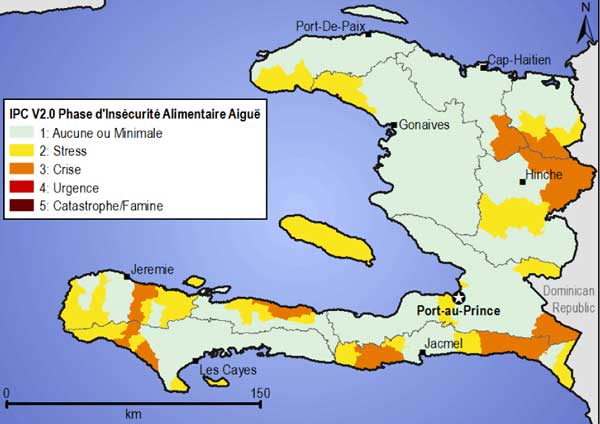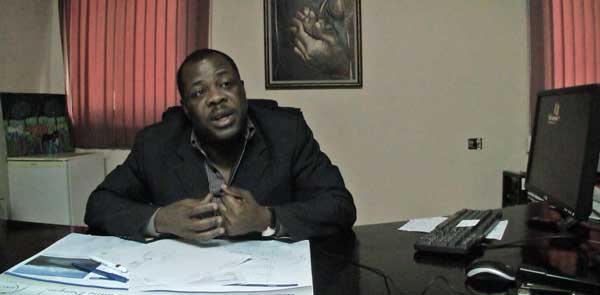Measuring Hunger
Port-au-Prince, HAITI, 10 October 2013 – In Haiti and in many countries around the world, hunger is “measured” by U.S. contractors and agencies. The statistics and predictions of who will suffer “stressed” or “crisis” food insecurity come from a U.S.-government funded program called Famine Early Warning System Network or “FEWS NET.”
Founded by the US government in 1984 after deadly famines in Africa, today “FEWS NET III” has a five-year budget of US$200 million, operates in 36 countries, and “plans to expand over the coming four years,” according to FEWS NET literature.
FEWS NET is run in Haiti and around the world by a U.S. contractor, Chemonics International. In addition to managing FEWS NET in Haiti, the firm also executes USAID’s US$126 million dollar WINNER agricultural program and has received at least $173 million in earthquake-related funding over the past three years. Chemonics is said to be the largest private recipient of USAID contracts worldwide. Chemonics has been criticized by the Government Accountability Office (GAO) and others for sloppy work and lack of accountability. [See here and here.]
Using data from U.S. agencies like United States Geological Survey (USGS), the National Aeronautics and Space Administration (NASA) and the United States Department of Agriculture (USDA), Chemonics technicians work with local field staff to analyze prices, rainfall, and other factors. This process results in “Food Security Outlook” reports.

FEWS NET outlook for July-September 2013.
For example, the FEWS NET prediction for July-December 2013 notes:
"Production from spring harvests will be 20 to 30 percent less than usual due to a shortage of seeds, together with the late start of the rains and the string of dry spells.
Ongoing harvests in areas with normal rainfall have brought down food prices in these parts of the country. However, prices in most areas are still 15 percent above those of July of last year.
With the poor 2012 harvest, this year’s lean season began unusually early and extended beyond the end of June in many areas, which is unusual. Mediocre crop performance and poor climatic conditions sharply reduced demand for agricultural labor, the source of approximately 30 percent of the annual income of poor households."
The FEWS NET recommendations and numbers are used by the UN’s Organization for the Coordination of Humanitarian Assistance (OCHA) and by many local and foreign humanitarian agencies, including food aid providers worldwide, the largest of whom is the U.S. government. [See Aid or Trade?]
Haiti’s Coordination Nationale de Securité Alimentaire (CNSA or National Coordination for Food Security) also uses the FEWS NET reports in its publications and collaborates closely with the office.
CNSA Director Pierre Gary Mathieu told HGW that about 80% of his agency’s activities and programs are funded and/or executed by foreign institutions like USAID, the World Food Program, and the European Union. CNSA’s budget and government funding runs only about 14 million gourdes (about US$325,500). When CNSA wants to do a study or carry out another activity, it has to seek approval and funding from one if its partners.

CNSA director Pierre Gary Mathieu.
Foreign actors prefer to have CNSA execute the studies, Mathieu explained, because they all use the numbers to justify their budgets and raise money for their programs..
“Don’t forget, all those agencies are in Haiti to operate, and they need data, whether it’s the World Food Program (WFP), the UN Food and Agriculture Program (FAO), or USAID,” he said. “If it were WFP or the FAO doing the study, journalists would ask questions, and wonder: 'Is WFP trying to justify something? Is USAID trying to justify something?' Therefore, when a… national agency does the study… it works in everyone’s interest.”
During another part of the July 2012 interview, however, Mathieu noted that once a foreign-funded study is completed, CNSA is barred from publishing until the funder has signed off.
“You give them the document and they validate it,” Mathieu told HGW, adding that he agrees with this step, since it assures the final report will be up to “standards.”
But not all actors feel the same way. Doudou Pierre Festil, a farmer who is also member of a national peasant movement and the coordinator of a network of about 200 farmers' associations and other organizations known as Réseau National Haïtien pour la Souveraineté et la Sécurité Alimentaire (RENAHSSA – National Network for Sovereignty and Food Security) claims that while the CNSA often participates in RENAHSSA activities, the agency is at the beck and call of its “partners.”
“Those NGOs are the ones supplying the information. Yes, the information appears to be good, but I think the CNSA should stop being subservient to the same NGOs that are distributing food aid,” Festil said.
(Note: FEWS NET is not funded by “NGOs.” It is 100% funded by the U.S. government.)
For the years 2009-2013, the U.S. government gave Haiti US$381.8 million dollars worth of food aid: 274,030 metric tons, according to agency documents. Most of the food was purchased from U.S. agribusinesses and went to the WFP, organizations like CARE, World Vision, and ACDI-VOCA, or to the Haitian government. [See Aid or Trade?]
Return to introduction of the series
Go to the next article Aid or Trade? – The nefarious effects of three decades of U.S. policy

